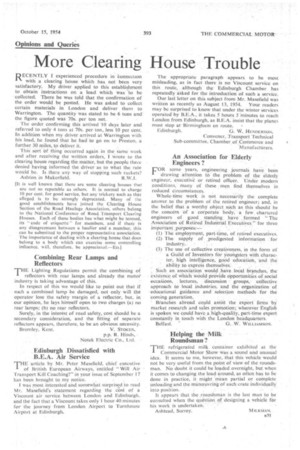Opinions and Queries
Page 65

If you've noticed an error in this article please click here to report it so we can fix it.
More Clearing
House Trouble RECENTLY I experienced procedure in t onneetton with a clearing house which has not been very satisfactory. My driver applied to this establishment to obtain instructions on a load which was to be ' collected. There he was told that the confirmation of the order would be posted. He was asked to collect certain materials in London and deliver them to Warrington. The quantity was stated to be 6 tons and the figure quoted was 70s. per ton net.
The order confirming this arrived 10 days later and referred to only 4 tons at 70s. per ton, less 10 per cent. In addition when my driver arrived at Warrinton with his load, he found that he had to go on to Preston. a further 30 miles, to deliver it.
This sort Of thing occurred again in the same week and after receiving the written orders, I wrote to the clearing house regarding the matter, but the people these denied having informed the driver as to what the rate would be. Is there any way of stopping such rackets?
Ashton in Makerfield. R.W.I.
[It is well known that there are some clearing houses that are not so reputable as others. It is normal to charge 10 per cent, for good service, but any trickery such as that alleged is to be strongly deprecated. Many of the good establishments have joined the Clearing House Section of the Road Haulage Association, others belong to the National Conference of Road, Transport Clearing Houses. Each of these bodies has what might be termed, its " code of etiquette for members, and if there is any disagreement between a haulier and a member, this can be submitted to the proper representative association. The importance of dealing with a clearing house that does belong to a body which can exercise some controlling influence, will, therefore, be appreciated.—ED.]
Combining Rear Lamps and Reflectors
THE Lighting Regulations permit the combining of reflectors with rear lamps and already the motor industry is taking advantage of this.
In respect of this we would like to point out that if such a combined lamp be damaged, not only will the operator lose the safety margin of a reflector, but, in our opinion, he lays himself open to two charges (a) no rear lamps; (b) no rear reflectors.
Surcly, in the interest of road safety, cost should be a secondary consideration, and the fitting of separate reflectors appears, therefore, to be an obvious necessity.
Bromley. Kent, V. STOKES, p.p. R. Hinds,
Notek Electric Co.. Ltd.
Edinburgh Dissatisfied with B.E.A. Air Service
'J THE article by Mr. Peter Masefield, chief executive 'HE British European Airways, 'entitled "Will Air Transport Kill Coaching?" in your issue of September 17
has been brought to my notice. .
I was most interested and somewhat surprised to read Mr. Masefield's statement regarding the cost of a Viscount air service between London and Edinburgh, and the fact that a Viscount takes only 1 hour 40 minutes for the journey from London Airport to Turnhouse Airport at Edinburgh.
The appropriate paragraph appears to be most misleading, as in fact there is no Viscount service on this route, . although the Edinburgh Chamber has repeatedly a:sked for the introduction of such a service.
Our last letter on this subject from Mr. Masefield was written as recently as August 13, 1954. Your readers may be surprised to know that under the winter services operated by B.E.A., it takes 5 hours 5 minutes to reach London from Edinburgh, as B.E.A. insist that the planes must stop at Birmingham en route.
Edinburgh. G. W. HENDERSON,
Convener, Transport Technical Sub-committee, Chamber of _Cornmerce and Manufacturers.
An Association for Elderly . Engineers ?
FOR some years, engineering journals have been
drawing attention to the problem of the elder,ly engineer, executive' or retired officer. Under modern conditions, many of .these men find themselves in reduced circumstances.
Whole-time work is not necessarily the complete answer to the problem of the retired engineer; and, in the belief that a worthy object such as this should be the concern of a corporate body, a few, chartered engineers of good. standing. have . formed The Association of Retired Industrial Executives "" for three important purpoSes:
(1) The employment, part-time, of retired executives.
(2) The supply of ,predigested information for industry.. : (3) The use of collective creativeness, in the form of a Guild of Inventors for Youngsters With character, high intelligence, good education, and the
. ability, to express themselves Such an association. would have local branches, the ex istence of which would provide opportunities of social occaSions, . lectures, discussion groups,. collective approach to local industries, and the organization of
• educational guidance and selection Methods for the coming generation.
Branches abroad could assist the export firms by market research and sales promotion; wherever English is spoken we could have.a.high-quality, part-time expert constantly in touch with the London headquarters.
Belfast. G. W. WILLIAMSON.
Helping the Milk Roundsman ?
THE refrigerated milk container exhibited at the Commercial Motor Show was a sound and unusual idea. It seems to me, however, that this vehicle would not be very useful from the point of view of the roundsman. No doubt it could be loaded overnight, but when it comes to changing the load around, as often has to be done in practice, it might mean partial or complete unloading and the manteuvring of each crate individually into position. It appears that the roundsman is the last man to be consulted when the question of designing a vehicle for his work is undertaken.
Ashteacl. Surrey.




































































































